Anatomy of the endocrine glands. Anatomy of the Endocrine System: A Comprehensive Guide to Glands and Hormones
How does the endocrine system control bodily functions. What are the major endocrine glands and their roles. How do hormones regulate metabolism, growth, and reproduction. What is the relationship between the nervous system and endocrine system.
The Endocrine System: An Overview of Glands and Hormones
The endocrine system is a complex network of glands and organs that uses hormones to regulate various bodily functions. This intricate system plays a crucial role in controlling metabolism, energy levels, reproduction, growth, development, stress response, and mood. Unlike the nervous system, which uses electrical signals for rapid communication, the endocrine system relies on chemical messengers called hormones for more gradual, long-lasting effects throughout the body.
How does the endocrine system differ from the nervous system in terms of communication? The nervous system uses both electrical and chemical signals (neurotransmitters) for fast, localized responses lasting milliseconds to seconds. In contrast, the endocrine system releases hormones into the bloodstream, affecting target cells throughout the body over a period of minutes to days or even longer.

The Hypothalamus: The Master Regulator of Endocrine Function
Located at the base of the brain, the hypothalamus serves as a critical link between the nervous system and the endocrine system. This small but powerful structure performs several vital functions:
- Controls the release of hormones from the pituitary gland
- Regulates body temperature, sleep-wake cycles, and appetite
- Influences mood and reproductive behaviors
- Maintains water balance and blood pressure
How does the hypothalamus exert such wide-ranging control over bodily functions? It does so by producing hormones that either stimulate or inhibit the release of other hormones from the pituitary gland, effectively acting as a master control center for the endocrine system.
The Pituitary Gland: The “Master Gland” of the Endocrine System
Often referred to as the “master gland,” the pituitary gland is a pea-sized structure located at the base of the brain, just below the hypothalamus. Despite its small size, the pituitary gland has an outsized influence on numerous bodily functions through the production and release of several important hormones:

- Growth hormone (GH): Promotes growth and cell reproduction
- Adrenocorticotropic hormone (ACTH): Stimulates the adrenal glands
- Thyroid-stimulating hormone (TSH): Controls thyroid gland function
- Follicle-stimulating hormone (FSH) and luteinizing hormone (LH): Regulate reproductive functions
- Prolactin: Stimulates milk production in females
- Antidiuretic hormone (ADH): Regulates water balance
- Oxytocin: Involved in childbirth and bonding
Why is the pituitary gland considered the “master gland” of the endocrine system? Its hormones control the function of many other endocrine glands, making it a crucial regulator of numerous physiological processes throughout the body.
The Thyroid and Parathyroid Glands: Regulators of Metabolism and Calcium Balance
Located in the neck, just below the larynx (voice box), the thyroid gland plays a vital role in regulating metabolism, energy production, and growth. The thyroid produces two main hormones:
- Thyroxine (T4)
- Triiodothyronine (T3)
These hormones influence nearly every cell in the body, controlling how quickly cells burn energy and produce proteins. The thyroid also produces calcitonin, which helps regulate calcium levels in the blood and bones.
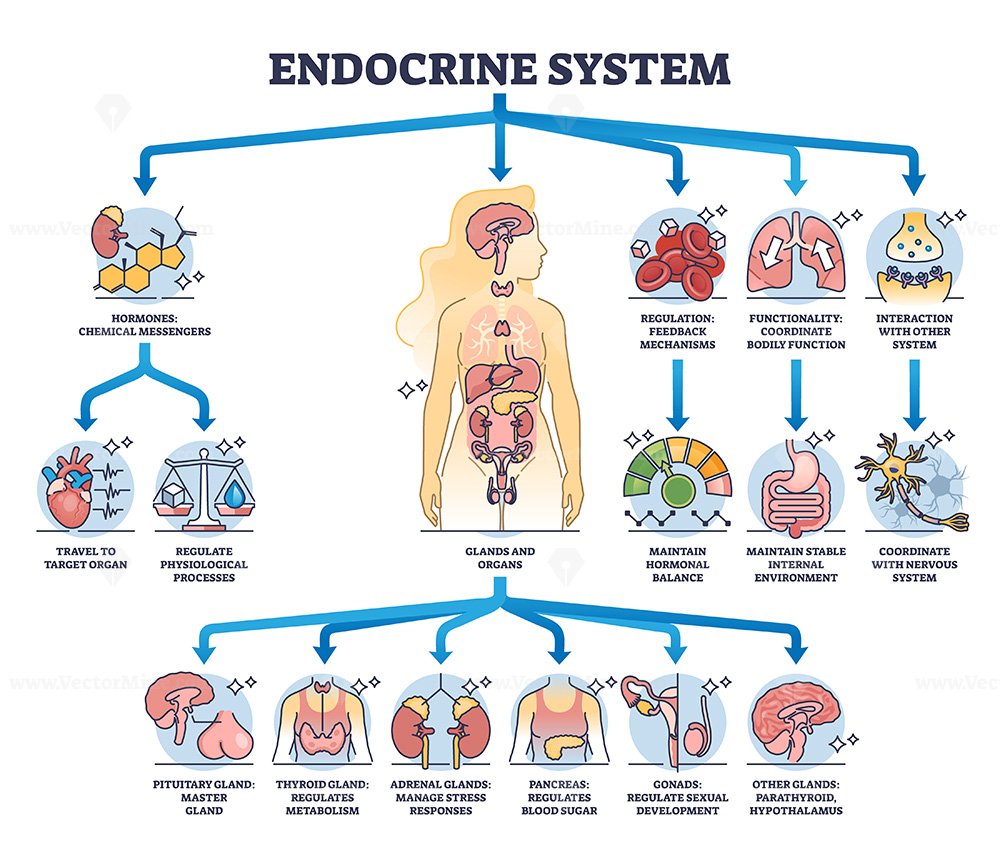
Adjacent to the thyroid gland are four small parathyroid glands, which produce parathyroid hormone (PTH). PTH works in concert with calcitonin to maintain proper calcium levels in the body, which is essential for strong bones, muscle function, and nerve signaling.
How do thyroid hormones affect metabolism? Thyroid hormones increase the basal metabolic rate, stimulating the consumption of oxygen and nutrients for energy production. This, in turn, influences body weight, heart rate, body temperature, and many other physiological processes.
The Adrenal Glands: Stress Response and Electrolyte Balance
Situated atop each kidney, the adrenal glands are composed of two distinct parts: the outer adrenal cortex and the inner adrenal medulla. Each part produces different hormones with unique functions:
Adrenal Cortex
- Glucocorticoids (e.g., cortisol): Regulate metabolism and stress response
- Mineralocorticoids (e.g., aldosterone): Control electrolyte balance
- Small amounts of sex hormones
Adrenal Medulla
- Epinephrine (adrenaline)
- Norepinephrine (noradrenaline)
What role do adrenal hormones play in the body’s stress response? When faced with stress, the adrenal glands release cortisol, epinephrine, and norepinephrine. These hormones trigger the “fight or flight” response, increasing heart rate, blood pressure, and blood sugar levels while diverting energy away from non-essential functions like digestion and reproduction.
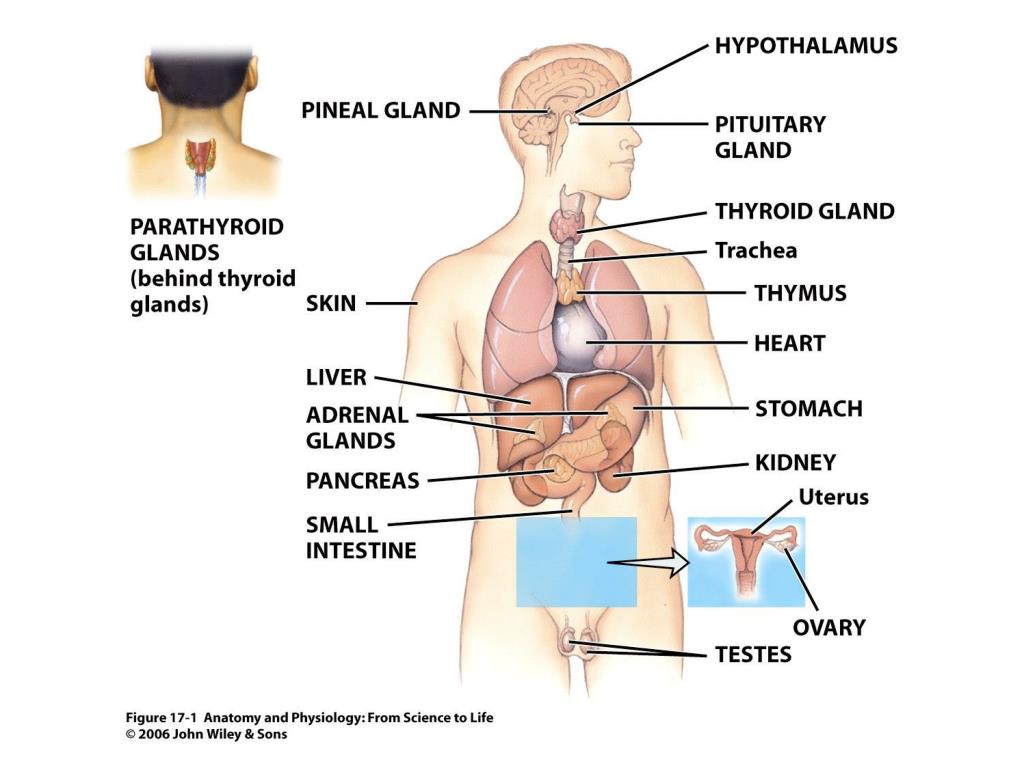
The Pancreas: Balancing Blood Sugar and Digestive Function
The pancreas is a unique organ that serves both endocrine and exocrine functions. As an endocrine gland, it produces several important hormones:
- Insulin: Lowers blood glucose levels
- Glucagon: Raises blood glucose levels
- Somatostatin: Regulates the release of other pancreatic hormones
- Pancreatic polypeptide: Helps regulate pancreatic secretions
The interplay between insulin and glucagon is crucial for maintaining proper blood sugar levels. When blood glucose rises, the pancreas releases insulin to promote glucose uptake by cells and storage as glycogen. Conversely, when blood glucose falls, glucagon stimulates the breakdown of glycogen and the production of glucose from other molecules.
How does the pancreas contribute to digestion? In its exocrine role, the pancreas produces digestive enzymes that are released into the small intestine to help break down carbohydrates, proteins, and fats.
The Reproductive Glands: Ovaries and Testes
The primary reproductive glands—ovaries in females and testes in males—produce sex hormones that regulate sexual development, reproduction, and secondary sexual characteristics.

Ovaries
Located on either side of the uterus, the ovaries produce:
- Estrogen: Promotes development of female secondary sexual characteristics and regulates the menstrual cycle
- Progesterone: Prepares the uterus for pregnancy and maintains pregnancy
- Inhibin: Regulates follicle-stimulating hormone (FSH) production
Testes
The testes, located in the scrotum, produce:
- Testosterone: Promotes development of male secondary sexual characteristics, sperm production, and muscle mass
- Inhibin: Regulates follicle-stimulating hormone (FSH) production
How do sex hormones influence puberty and sexual maturation? During puberty, increased production of sex hormones triggers the development of secondary sexual characteristics, such as breast development in females and facial hair growth in males. These hormones also regulate the reproductive cycle and fertility throughout adulthood.
The Pineal Gland: Regulator of Circadian Rhythms
The pineal gland, a small endocrine gland located in the brain, produces melatonin, a hormone that plays a crucial role in regulating sleep-wake cycles and circadian rhythms. Melatonin production is influenced by light exposure, with levels typically rising in the evening and falling in the morning.

In addition to its role in sleep regulation, the pineal gland and melatonin have been implicated in various other physiological processes:
- Seasonal reproduction in some animals
- Antioxidant effects
- Immune system modulation
- Regulation of body temperature
- Influence on mood and mental health
How does light exposure affect melatonin production and sleep patterns? Light exposure, particularly blue light from electronic devices, can suppress melatonin production, potentially disrupting sleep-wake cycles. This is why sleep experts often recommend limiting screen time before bedtime to promote better sleep quality.
Hormonal Feedback Loops: Maintaining Endocrine Balance
The endocrine system relies on complex feedback loops to maintain hormonal balance and homeostasis. These feedback mechanisms can be either negative or positive:
Negative Feedback
Negative feedback is the most common type of endocrine regulation. In this system, the response to a stimulus reduces or inhibits further stimulation. For example:

- The hypothalamus detects low thyroid hormone levels in the blood.
- It releases thyrotropin-releasing hormone (TRH).
- TRH stimulates the pituitary to release thyroid-stimulating hormone (TSH).
- TSH prompts the thyroid gland to produce and release more thyroid hormones.
- As thyroid hormone levels rise, they inhibit the release of TRH and TSH, completing the negative feedback loop.
Positive Feedback
Positive feedback is less common but occurs in certain situations, such as childbirth and blood clotting. In these cases, the initial stimulus promotes further stimulation, creating a self-reinforcing cycle. For example, during childbirth:
- Contractions stimulate the release of oxytocin from the pituitary gland.
- Oxytocin increases the strength and frequency of contractions.
- Stronger contractions lead to more oxytocin release.
- This cycle continues until the baby is born, at which point the stimulus (pressure on the cervix) is removed.
Why are feedback loops essential for endocrine function? These mechanisms help maintain hormonal balance and prevent overproduction or underproduction of hormones, which could lead to various endocrine disorders.
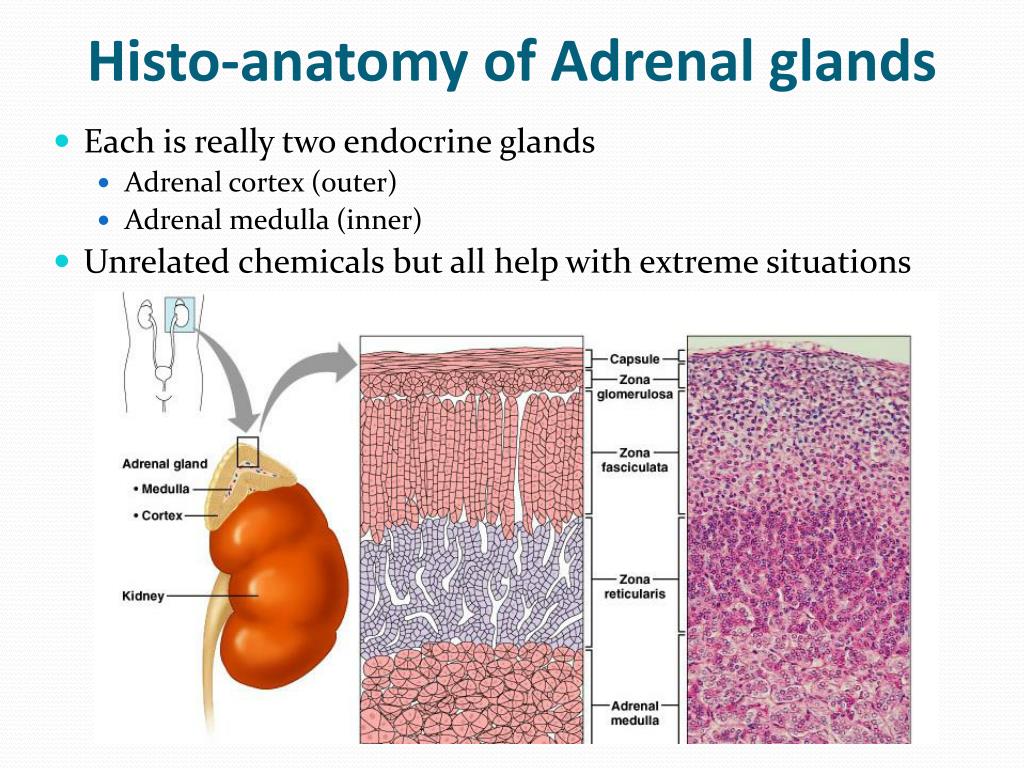
Endocrine Disorders: When Hormonal Balance Goes Awry
Endocrine disorders occur when glands produce too much or too little of a hormone, or when the body doesn’t respond properly to hormones. Some common endocrine disorders include:
- Diabetes mellitus: Insufficient insulin production or insulin resistance
- Hypothyroidism: Underactive thyroid gland
- Hyperthyroidism: Overactive thyroid gland
- Cushing’s syndrome: Excess cortisol production
- Addison’s disease: Insufficient adrenal hormone production
- Polycystic ovary syndrome (PCOS): Hormonal imbalance affecting ovarian function
- Growth hormone deficiency or excess
How are endocrine disorders diagnosed and treated? Diagnosis often involves blood tests to measure hormone levels, imaging studies to examine gland structure, and assessment of symptoms. Treatment may include hormone replacement therapy, medications to block or stimulate hormone production, surgery, or lifestyle changes, depending on the specific disorder and its underlying cause.

The Endocrine System and Aging: Hormonal Changes Throughout Life
As we age, the endocrine system undergoes various changes that can affect hormone production and tissue responsiveness to hormones. Some age-related endocrine changes include:
- Decreased growth hormone production
- Reduced testosterone levels in men (andropause)
- Decreased estrogen and progesterone in women (menopause)
- Altered thyroid function
- Changes in insulin sensitivity and glucose metabolism
- Decreased production of melatonin, affecting sleep patterns
These hormonal shifts can contribute to various age-related changes, such as decreased muscle mass, increased body fat, reduced bone density, and changes in energy levels and mood.
How can one support healthy endocrine function throughout life? Maintaining a healthy lifestyle through proper nutrition, regular exercise, stress management, and adequate sleep can help support endocrine health as we age. Additionally, regular check-ups and screenings can help detect and address any hormonal imbalances or endocrine disorders early on.
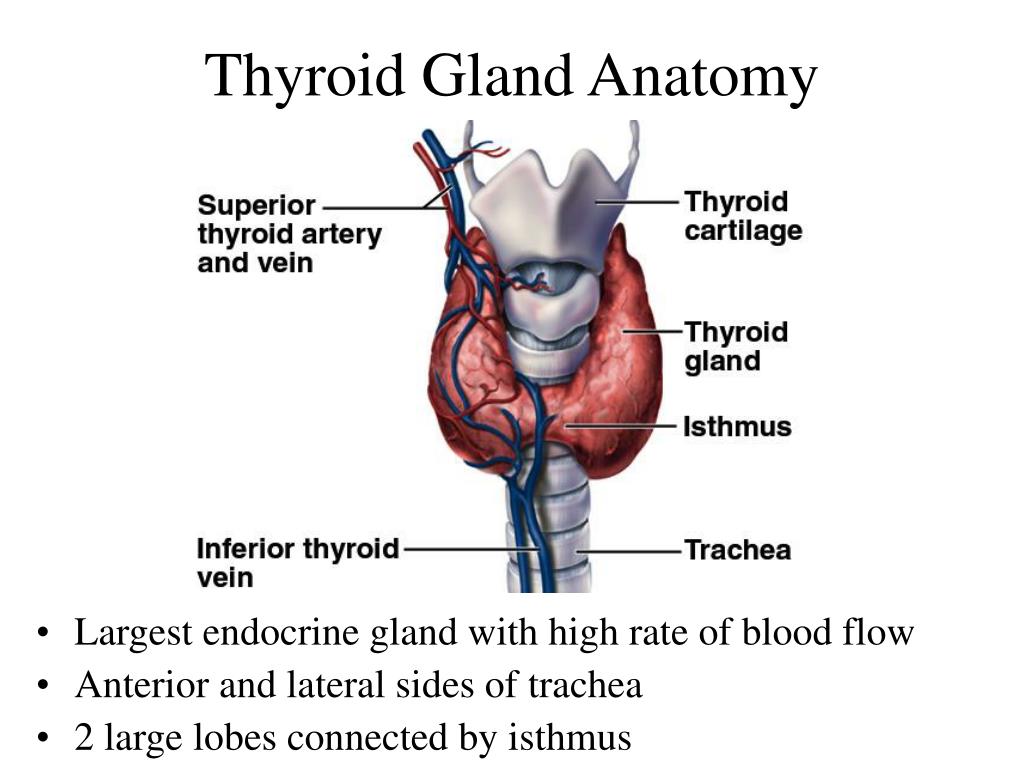
The Future of Endocrine Research: Emerging Trends and Potential Therapies
Endocrine research continues to advance our understanding of hormonal regulation and its impact on health and disease. Some exciting areas of current and future research include:
- Endocrine disruptors: Investigating the effects of environmental chemicals on hormone function
- Chronobiology: Exploring the relationship between circadian rhythms and endocrine function
- Epigenetics: Studying how environmental factors can influence gene expression and hormone production
- Hormone replacement therapies: Developing more targeted and personalized approaches
- Endocrine-immune interactions: Understanding the complex relationship between hormones and the immune system
- Gut-brain axis: Investigating the role of gut hormones in appetite regulation and metabolism
- Artificial intelligence and big data: Using advanced analytics to identify patterns and predict endocrine disorders
What potential breakthroughs might emerge from these research areas? Future advancements could lead to more precise diagnostic tools, personalized treatment strategies, and novel therapies for endocrine disorders. Additionally, a deeper understanding of hormonal interactions could pave the way for interventions that promote healthy aging and improve overall quality of life.
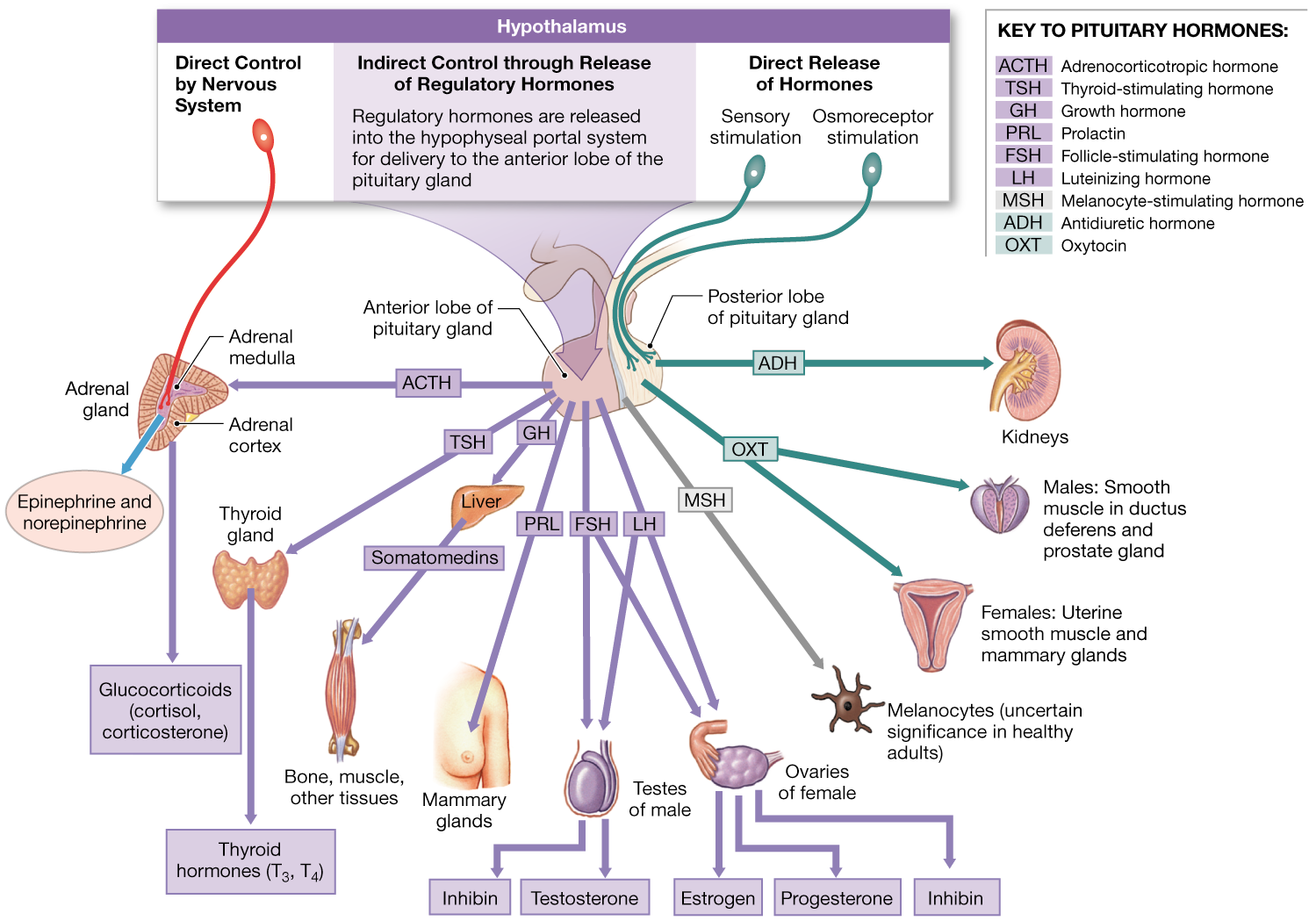
As our knowledge of the endocrine system continues to grow, so too does our appreciation for its intricate role in maintaining health and well-being. From regulating metabolism and growth to influencing mood and behavior, the endocrine system touches nearly every aspect of human physiology. By continuing to unravel its mysteries, we move closer to unlocking new ways to prevent, diagnose, and treat a wide range of health conditions, ultimately improving lives around the world.
Anatomy of the Endocrine System
The endocrine system is a complex network of glands and organs. It uses hormones to control and coordinate your body’s metabolism, energy level, reproduction, growth and development, and response to injury, stress, and mood. The following are key parts of the endocrine system:
-
Hypothalamus. The hypothalamus is located at the base of the brain. It makes hormones that control hormones released in the pituitary gland. The hypothalamus controls water balance, sleep, temperature, appetite, mood, reproductive behaviors, and blood pressure.
-
Pineal gland. This gland is located in the middle of the brain. It makes the hormone melatonin. This hormone helps your body know when it’s time to sleep. This hormone also regulates the timing of other functions throughout the body, such as when puberty starts.
-
Pituitary gland.
 This gland is located below the brain. It is often as small as a pea. But it controls many functions of the other endocrine glands.
This gland is located below the brain. It is often as small as a pea. But it controls many functions of the other endocrine glands. -
Thyroid and parathyroid. These glands are located in front of the neck, below the voice box (larynx). The thyroid plays a key role in the body’s metabolism. The parathyroid helps regulate the body’s calcium balance and bone strength.
-
Adrenal gland. An adrenal gland is located on top of each kidney. Like many glands, these work together with the hypothalamus and pituitary gland. The adrenal glands make and release corticosteroid hormones and adrenaline (epinephrine). These maintain blood pressure and regulate metabolism.
-
Pancreas. This organ is located across the back of the belly (abdomen), behind the stomach. It plays a role in digestion and hormone production.
 Hormones made by the pancreas include insulin and glucagon. These regulate blood sugar levels.
Hormones made by the pancreas include insulin and glucagon. These regulate blood sugar levels. -
Ovaries. A woman’s ovaries are located on both sides of the uterus, below the opening of the fallopian tubes. The ovaries contain the egg cells needed for reproduction. They also make estrogen and progesterone.
-
Testes. A man’s testes are located in a pouch that hangs suspended outside the male body. The testes make testosterone and sperm.
Online Medical Reviewer:
Raymond Kent Turley BSN MSN RN
Online Medical Reviewer:
Rita Sather RN
Online Medical Reviewer:
Robert Hurd MD
Date Last Reviewed:
4/1/2022
© 2000-2023 The StayWell Company, LLC. All rights reserved.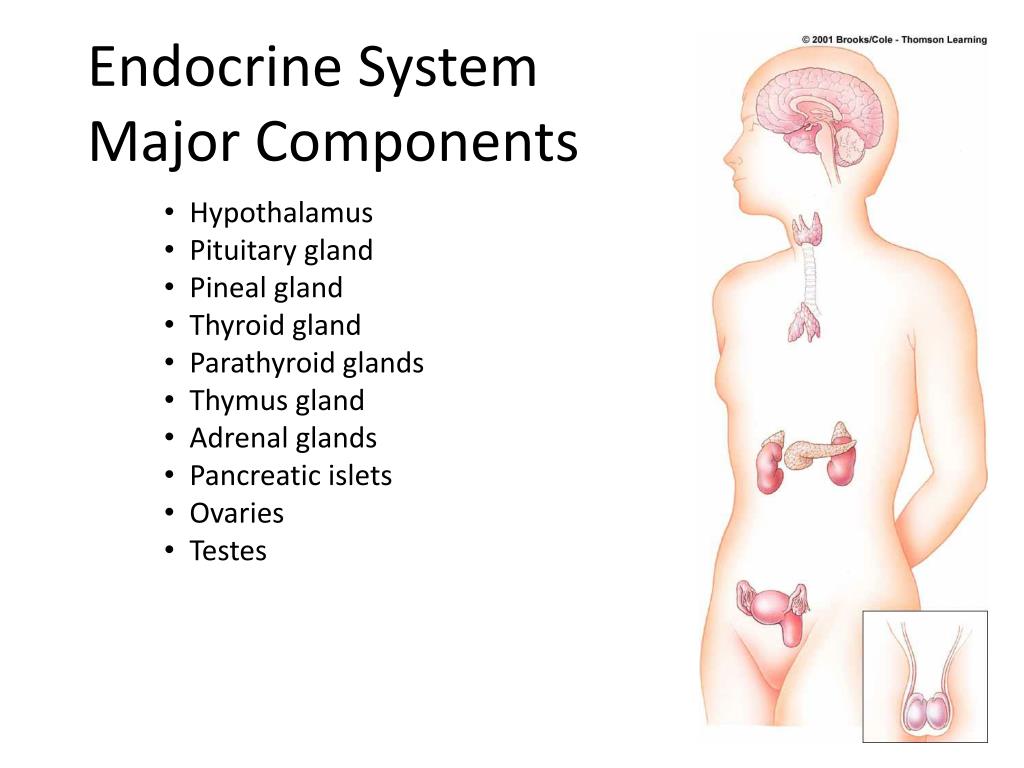 This information is not intended as a substitute for professional medical care. Always follow your healthcare professional’s instructions.
This information is not intended as a substitute for professional medical care. Always follow your healthcare professional’s instructions.
17.1 An Overview of the Endocrine System – Anatomy and Physiology 2e
Learning Objectives
By the end of this section, you will be able to:
- Distinguish the types of intercellular communication, their importance, mechanisms, and effects
- Identify the major organs and tissues of the endocrine system and their location in the body
Communication is a process in which a sender transmits signals to one or more receivers to control and coordinate actions. In the human body, two major organ systems participate in relatively “long distance” communication: the nervous system and the endocrine system. Together, these two systems are primarily responsible for maintaining homeostasis in the body.
Neural and Endocrine Signaling
The nervous system uses two types of intercellular communication—electrical and chemical signaling—either by the direct action of an electrical potential, or in the latter case, through the action of chemical neurotransmitters such as serotonin or norepinephrine.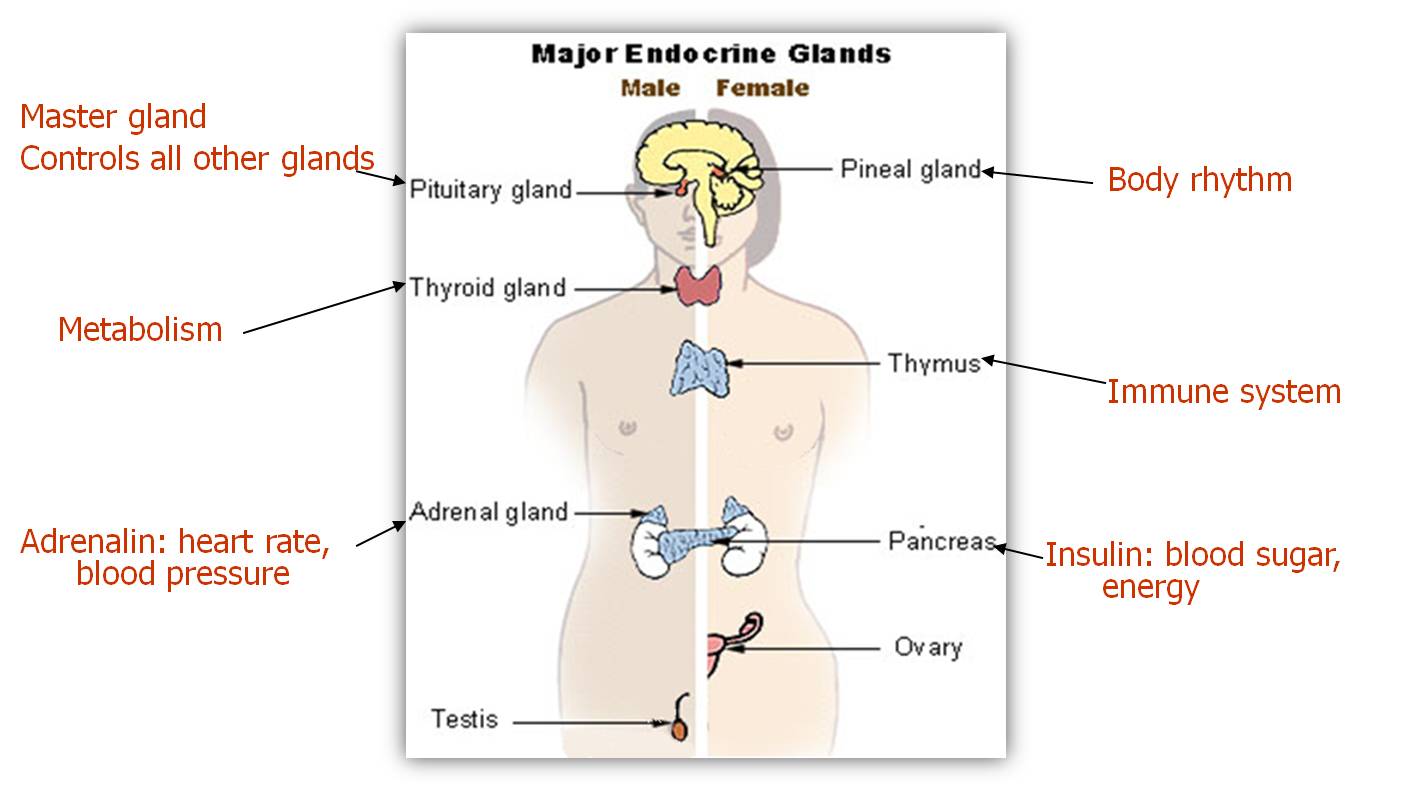 Neurotransmitters act locally and rapidly. When an electrical signal in the form of an action potential arrives at the synaptic terminal, they diffuse across the synaptic cleft (the gap between a sending neuron and a receiving neuron or muscle cell). Once the neurotransmitters interact (bind) with receptors on the receiving (post-synaptic) cell, the receptor stimulation is transduced into a response such as continued electrical signaling or modification of cellular response. The target cell responds within milliseconds of receiving the chemical “message”; this response then ceases very quickly once the neural signaling ends. In this way, neural communication enables body functions that involve quick, brief actions, such as movement, sensation, and cognition.In contrast, the endocrine system uses just one method of communication: chemical signaling. These signals are sent by the endocrine organs, which secrete chemicals—the hormone—into the extracellular fluid. Hormones are transported primarily via the bloodstream throughout the body, where they bind to receptors on target cells, inducing a characteristic response.
Neurotransmitters act locally and rapidly. When an electrical signal in the form of an action potential arrives at the synaptic terminal, they diffuse across the synaptic cleft (the gap between a sending neuron and a receiving neuron or muscle cell). Once the neurotransmitters interact (bind) with receptors on the receiving (post-synaptic) cell, the receptor stimulation is transduced into a response such as continued electrical signaling or modification of cellular response. The target cell responds within milliseconds of receiving the chemical “message”; this response then ceases very quickly once the neural signaling ends. In this way, neural communication enables body functions that involve quick, brief actions, such as movement, sensation, and cognition.In contrast, the endocrine system uses just one method of communication: chemical signaling. These signals are sent by the endocrine organs, which secrete chemicals—the hormone—into the extracellular fluid. Hormones are transported primarily via the bloodstream throughout the body, where they bind to receptors on target cells, inducing a characteristic response.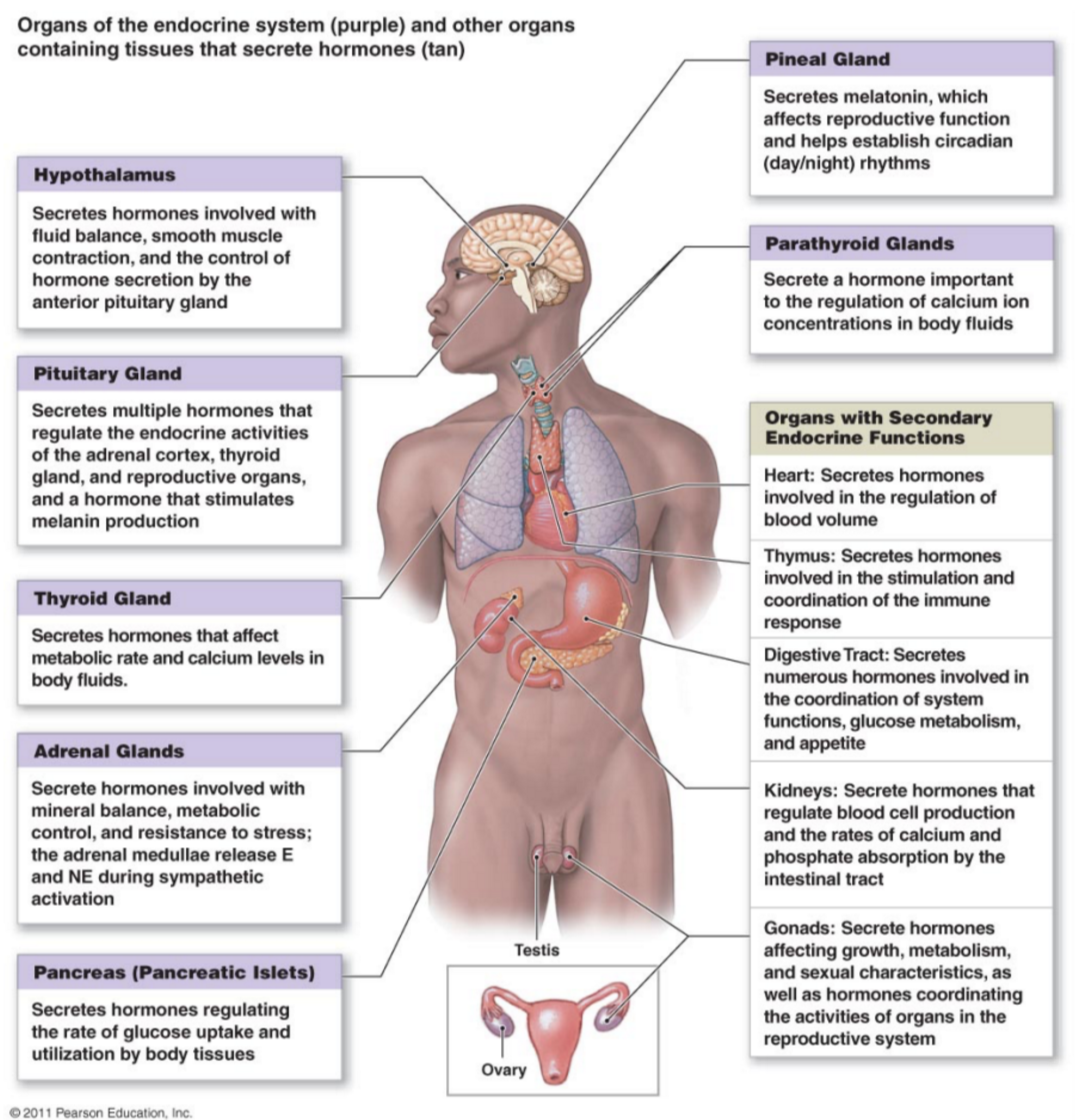 As a result, endocrine signaling requires more time than neural signaling to prompt a response in target cells, though the precise amount of time varies with different hormones. For example, the hormones released when you are confronted with a dangerous or frightening situation, called the fight-or-flight response, occur by the release of adrenal hormones—epinephrine and norepinephrine—within seconds. In contrast, it may take up to 48 hours for target cells to respond to certain reproductive hormones.
As a result, endocrine signaling requires more time than neural signaling to prompt a response in target cells, though the precise amount of time varies with different hormones. For example, the hormones released when you are confronted with a dangerous or frightening situation, called the fight-or-flight response, occur by the release of adrenal hormones—epinephrine and norepinephrine—within seconds. In contrast, it may take up to 48 hours for target cells to respond to certain reproductive hormones.
Interactive Link
Visit this link to watch an animation of the events that occur when a hormone binds to a cell membrane receptor. What is the secondary messenger made by adenylyl cyclase during the activation of liver cells by epinephrine?
In addition, endocrine signaling is typically less specific than neural signaling. The same hormone may play a role in a variety of different physiological processes depending on the target cells involved. For example, the hormone oxytocin promotes uterine contractions in people in labor. It is also important in breastfeeding, and may be involved in the sexual response and in feelings of emotional attachment in humans.
It is also important in breastfeeding, and may be involved in the sexual response and in feelings of emotional attachment in humans.
In general, the nervous system involves quick responses to rapid changes in the external environment, and the endocrine system is usually slower acting—taking care of the internal environment of the body, maintaining homeostasis, and controlling reproduction (Table 17.1). So how does the fight-or-flight response that was mentioned earlier happen so quickly if hormones are usually slower acting? It is because the two systems are connected. It is the fast action of the nervous system in response to the danger in the environment that stimulates the adrenal glands to secrete their hormones. As a result, the nervous system can cause rapid endocrine responses to keep up with sudden changes in both the external and internal environments when necessary.
Endocrine and Nervous Systems
| Endocrine system | Nervous system | |
|---|---|---|
| Signaling mechanism(s) | Chemical | Chemical/electrical |
| Primary chemical signal | Hormones | Neurotransmitters |
| Distance traveled | Long or short | Always short |
| Response time | Fast or slow | Always fast |
| Environment targeted | Internal | Internal and external |
Table
17.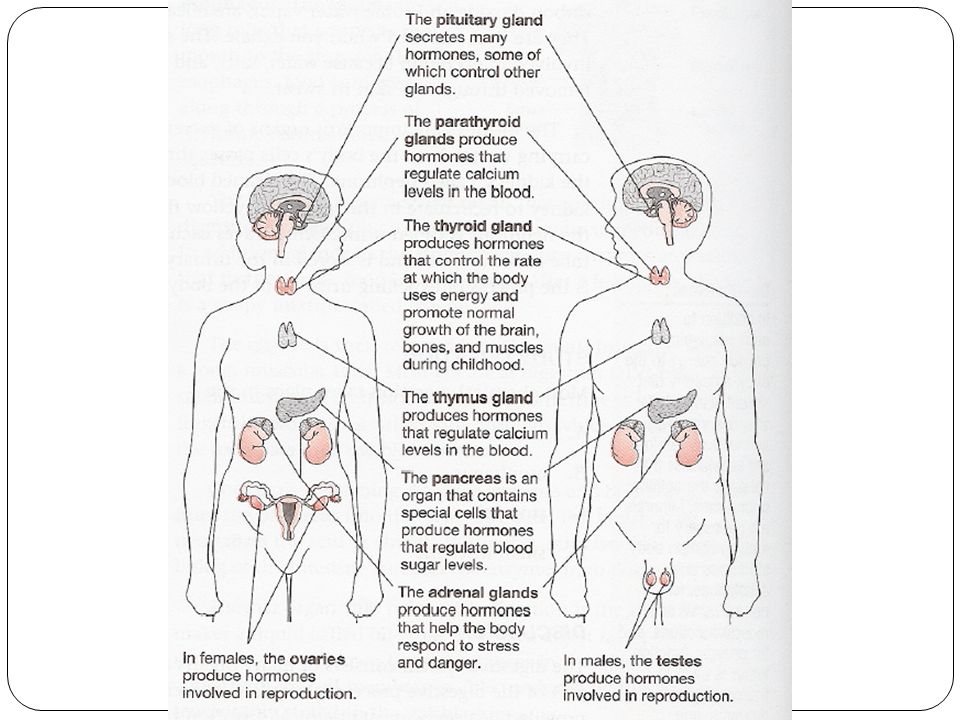 1
1
Structures of the Endocrine System
The endocrine system consists of cells, tissues, and organs that secrete hormones as a primary or secondary function. The endocrine gland is the major player in this system. The primary function of these ductless glands is to secrete their hormones directly into the surrounding fluid. The interstitial fluid and the blood vessels then transport the hormones throughout the body. The endocrine system includes the pituitary, thyroid, parathyroid, adrenal, and pineal glands (Figure 17.2). Some of these glands have both endocrine and non-endocrine functions. For example, the pancreas contains cells that function in digestion as well as cells that secrete the hormones insulin and glucagon, which regulate blood glucose levels. The hypothalamus, thymus, heart, kidneys, stomach, small intestine, liver, skin, ovaries, and testes are other organs that contain cells with endocrine function. Moreover, adipose tissue has long been known to produce hormones, and recent research has revealed that even bone tissue has endocrine functions.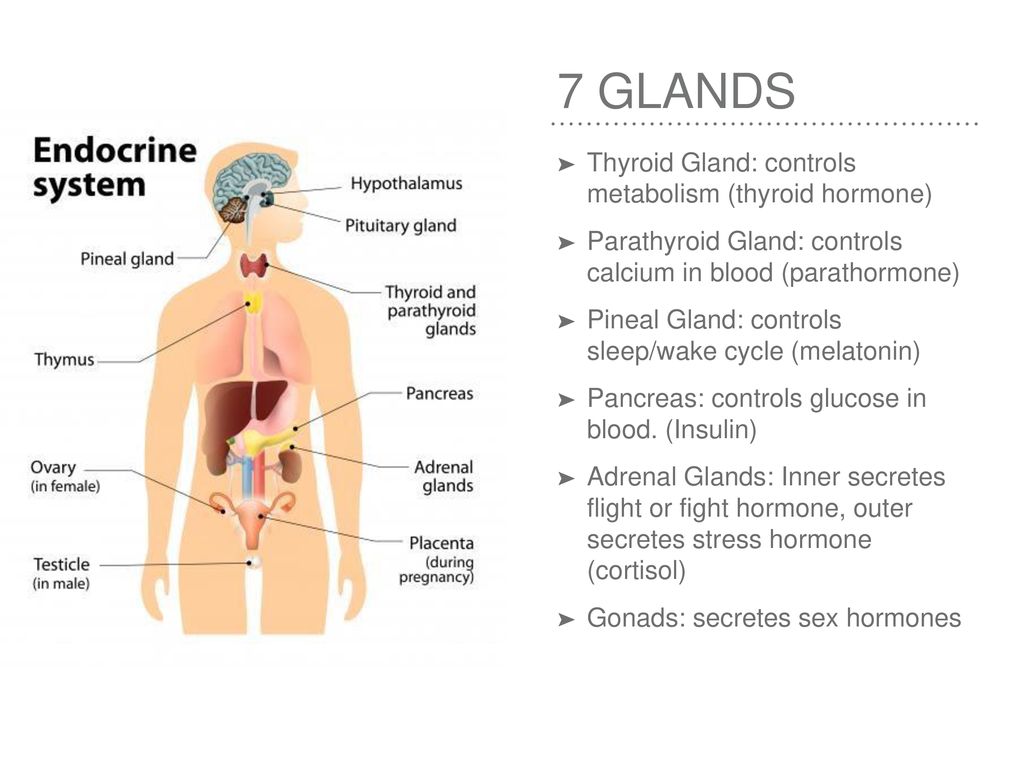
Figure
17.2
Endocrine System
Endocrine glands and cells are located throughout the body and play an important role in homeostasis.
The ductless endocrine glands are not to be confused with the body’s exocrine system, whose glands release their secretions through ducts. Examples of exocrine glands include the sebaceous and sweat glands of the skin. As just noted, the pancreas also has an exocrine function: most of its cells secrete pancreatic juice through the pancreatic and accessory ducts to the lumen of the small intestine.
Other Types of Chemical Signaling
In endocrine signaling, hormones secreted into the extracellular fluid diffuse into the blood or lymph, and can then travel great distances throughout the body. In contrast, autocrine signaling takes place within the same cell. An autocrine (auto- = “self”) is a chemical that elicits a response in the same cell that secreted it. Interleukin-1, or IL-1, is a signaling molecule that plays an important role in inflammatory response.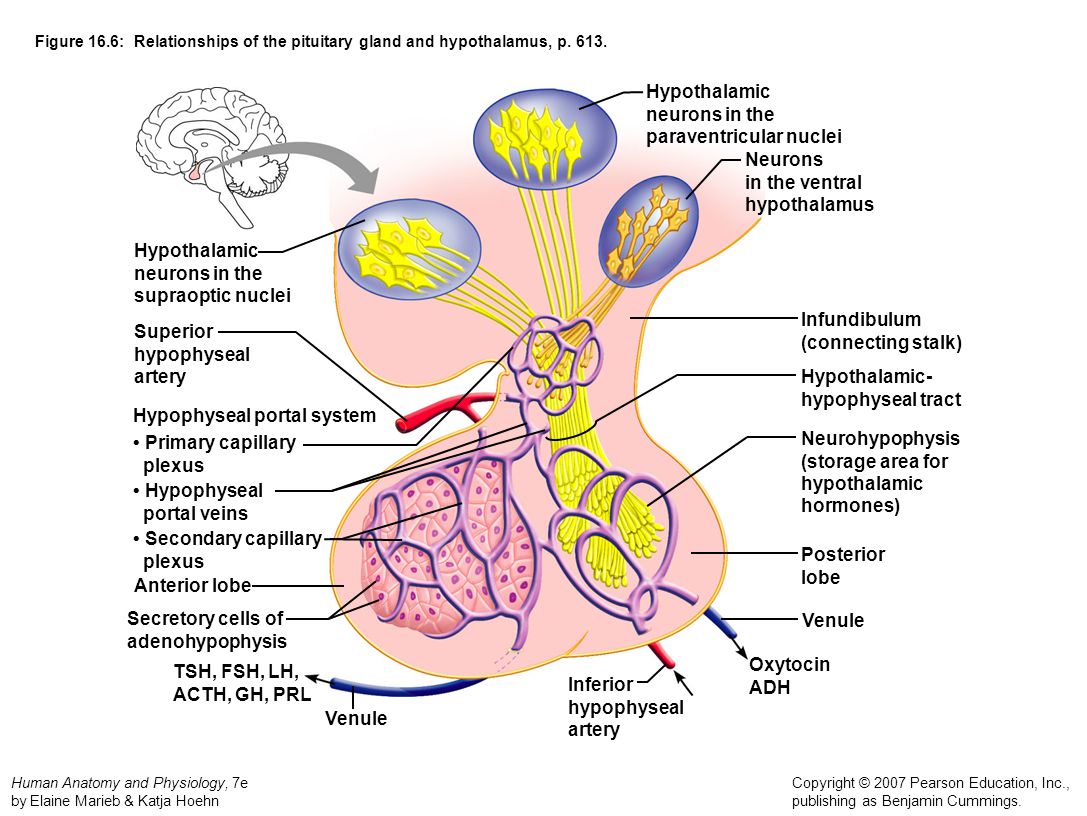 The cells that secrete IL-1 have receptors on their cell surface that bind these molecules, resulting in autocrine signaling.
The cells that secrete IL-1 have receptors on their cell surface that bind these molecules, resulting in autocrine signaling.
Local intercellular communication is the province of the paracrine, also called a paracrine factor, which is a chemical that induces a response in neighboring cells. Although paracrines may enter the bloodstream, their concentration is generally too low to elicit a response from distant tissues. A familiar example to those with asthma is histamine, a paracrine that is released by immune cells in the bronchial tree. Histamine causes the smooth muscle cells of the bronchi to constrict, narrowing the airways. Another example is the neurotransmitters of the nervous system, which act only locally within the synaptic cleft.
Career Connection
Endocrinologist
Endocrinology is a specialty in the field of medicine that focuses on the treatment of endocrine system disorders. Endocrinologists—medical doctors who specialize in this field—are experts in treating diseases associated with hormonal systems, ranging from thyroid disease to diabetes mellitus. Endocrine surgeons treat endocrine disease through the removal, or resection, of the affected endocrine gland.
Endocrine surgeons treat endocrine disease through the removal, or resection, of the affected endocrine gland.
Patients who are referred to endocrinologists may have signs and symptoms or blood test results that suggest excessive or impaired functioning of an endocrine gland or endocrine cells. The endocrinologist may order additional blood tests to determine whether the patient’s hormonal levels are abnormal, or they may stimulate or suppress the function of the suspect endocrine gland and then have blood taken for analysis. Treatment varies according to the diagnosis. Some endocrine disorders, such as type 2 diabetes, may respond to lifestyle changes such as modest weight loss, adoption of a healthy diet, and regular physical activity. Other disorders may require medication, such as hormone replacement, and routine monitoring by the endocrinologist. These include disorders of the pituitary gland that can affect growth and disorders of the thyroid gland that can result in a variety of metabolic problems.
Some patients experience health problems as a result of the normal decline in hormones that can accompany aging. These patients can consult with an endocrinologist to weigh the risks and benefits of hormone replacement therapy intended to boost their natural levels of reproductive hormones.
In addition to treating patients, endocrinologists may be involved in research to improve the understanding of endocrine system disorders and develop new treatments for these diseases.
Anatomy
Topic: Morphofunctional characteristics of the organs of the endocrine apparatus,
topography and role in the regulation of the activity of organs and systems of the body.
Plan :
- General characteristics of the endocrine glands
- Topography
- Regulation of the activity of organs and systems of the body.

Endocrine glands (glandulae endocrinae, from Greek endo – inside, krino
– I allocate), or endocrine glands, are called glands, the main
whose functions are the formation and release into the blood of special active
chemicals – hormones. Hormones have a regulating effect on
functions of the whole organism and individual organs, mainly on different sides
metabolism.
The endocrine glands include the pituitary gland, pineal gland, thyroid gland, parathyroid
the prominent glands, the thymus gland, the endocrine part (islands) of the pancreas
glands, adrenal glands, endocrine part of the gonads (ovaries in women, testicles in
men). Endocrine function is inherent in many other organs (different departments
alimentary canal, kidney, etc. ), but in them it is not the main one.
), but in them it is not the main one.
Endocrine glands are formed from rudiments arising from different germ layers.
From the ectoderm, the rudiments of the pituitary gland, pineal gland and medulla develop.
adrenal glands, from the endoderm – the thyroid gland, parathyroid glands,
thymus gland and the endocrine part of the pancreas, from the mesoderm –
rudiments of the cortical substance of the adrenal glands and gonads.
Endocrine glands differ not only in their development, but also in structure, and
also by the chemical composition and action of the hormones they secrete, but all these glands
have common anatomical and physiological features. First of all, they are glands, not
having excretory ducts. The main tissue of almost all endocrine glands,
determining their function is the glandular epithelium.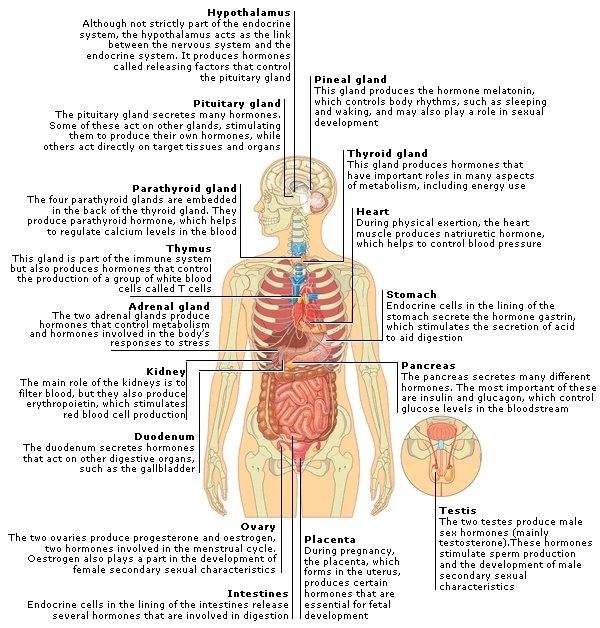 Wealth is celebrated
Wealth is celebrated
blood supply to the glands. Compared to other organs for the same mass, they
receive significantly more blood, which is due to the intensity of metabolism in
glands and the release of hormones into the bloodstream. Within each gland there is a plentiful
a network of blood capillaries, the diameter of which can reach 20-30 microns or more
(they are called sinusoids).
Endocrine glands are supplied with a large number of nerve fibers, mainly
autonomic nervous system.
These glands are a single system of endocrine organs. leading role in this
The system is played by the pituitary gland. The anterior pituitary gland produces the so-called tropic
hormones that regulate almost all other endocrine glands.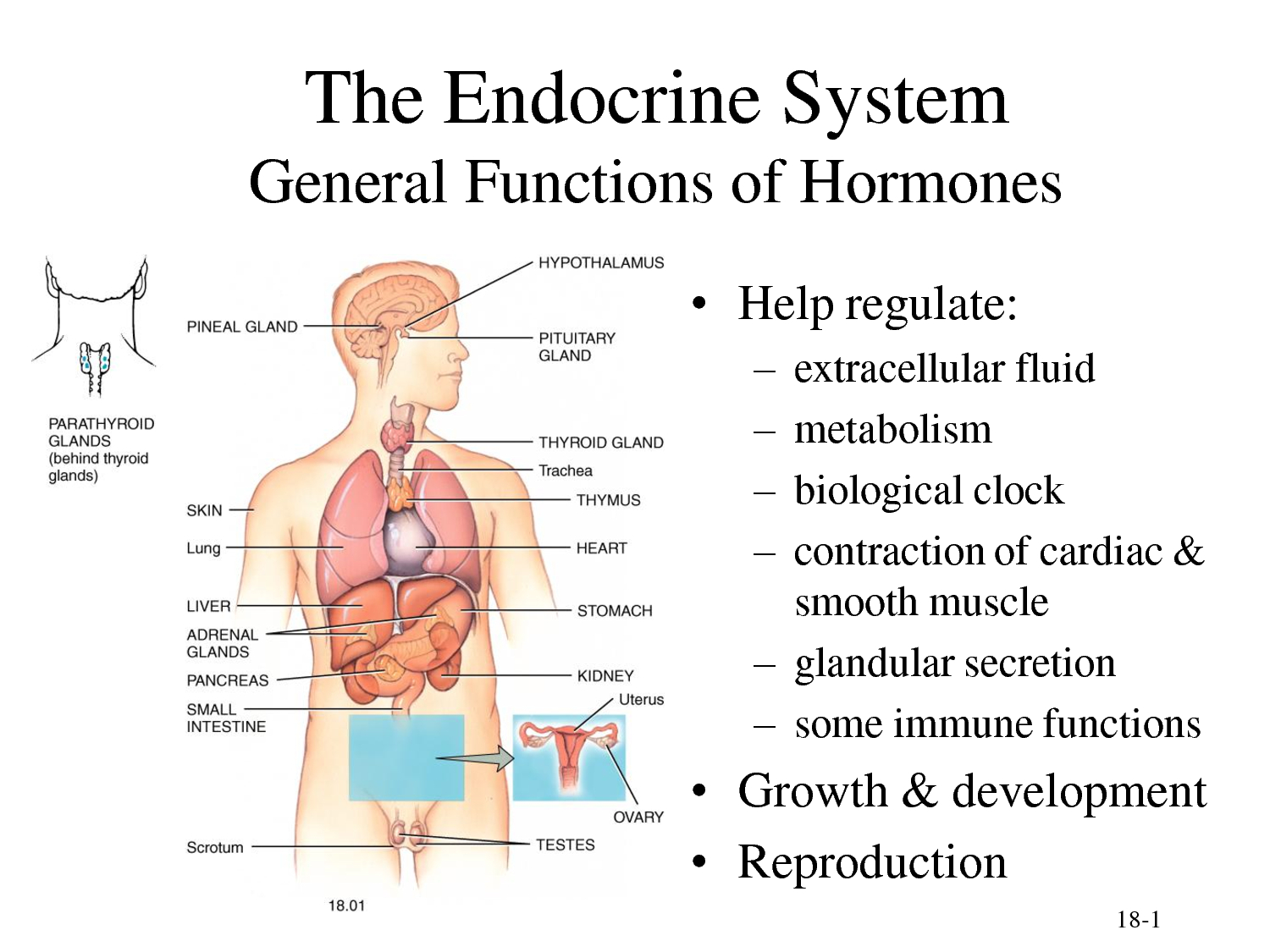 In my
In my
secretory activity of the anterior pituitary gland is regulated by the hypothalamus
(section of the diencephalon). Neurosecretory cells (nucleus) of the hypothalamus secrete
special hormones that affect the secretion of tropic hormones in the pituitary gland. Influence at
the activity of the endocrine glands, the nervous system has not only indirectly
– through the pituitary gland, but also through the nerves going to the glands.
The pituitary gland (hypophysis) is a small gland of the ovoid
forms weighing up to 0.7 g. It is located on the inner base of the skull, in the fossa
Turkish saddle of the sphenoid bone, covered from above by the process of the dura mater
shells (saddle diaphragm). With the help of the so-called pituitary stalk (funnel)
With the help of the so-called pituitary stalk (funnel)
the pituitary gland is connected to the gray tubercle, which is part of the hypothalamus. in the pituitary gland
There are two lobes: anterior and posterior. The anterior lobe developed by protrusion from
the oral bay of the embryo, consists of glandular epithelial cells and is called
adenogi – iophysis. In the anterior lobe, several parts are distinguished. The part adjacent to
posterior lobe of the pituitary gland, called the intermediate
Glandular cells, anterior pituitary gland differ in their structure and
secreted hormones: somatotropic cells secrete somatotropic hormone (hormone
growth), mammotropic cells – lactotropic hormone (affects
function of the mammary glands and corpus luteum in the ovaries), corticotropic cells –
adrenocorticotropic hormone – ACTH (affects the function of the cortical substance
adrenal glands. ), thyroid-stimulating cells – thyroid-stimulating hormone (stimulates
), thyroid-stimulating cells – thyroid-stimulating hormone (stimulates
thyroid hormone production), gonadotropic cells – gonadotropic
hormones (have an effect on the sex glands – gonads). Intermediate
The anterior pituitary contains glandular epithelial cells that produce
melanotropin hormone (regulates pigment metabolism).
The posterior lobe of the pituitary developed by protrusion from the diencephalon, consists of
neuroglial cells and is called the neurohypophysis. It secretes two hormones: vasopressin,
or antidiuretic hormone, and oxytocin. These hormones are produced
non-secretory cells of the hypothalamus and along the nerve fibers going from them to
As part of the funnel, they enter the posterior lobe of the pituitary gland, where they accumulate (deposit).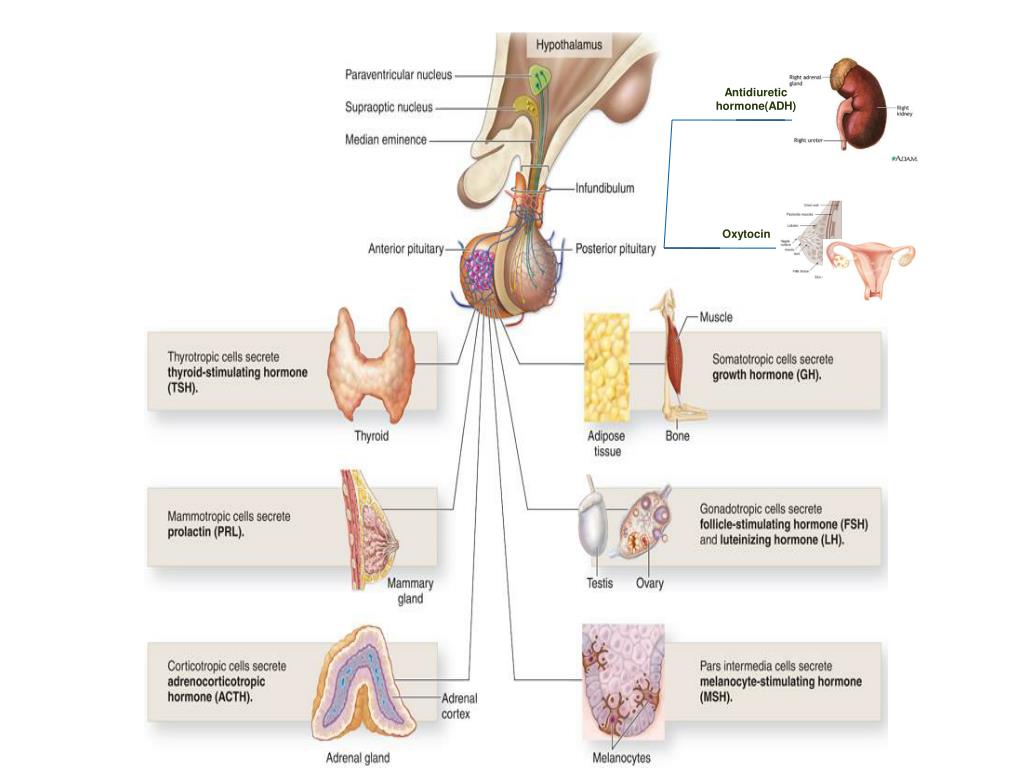
From the posterior lobe, as needed, they enter the bloodstream.
The pineal body (corpus pineale), or the epiphysis of the brain, represents
is a small organ weighing up to 0.25 g, shaped like a fir cone. He
located in the cranial cavity above the plate of the roof of the midbrain in the groove between the two
upper mounds; with the help of the so-called leashes, it is connected with the visual tubercles
diencephalon
The pineal body is covered with a connective tissue sheath from which
trabeculae (transitions), dividing the substance of the gland into small lobules. In slices
there are polygonal-shaped cells called pinealocytes, and neuroglia cells.
The thyroid gland (glandula thyroidea) is the largest of
endocrine glands, its mass in an adult reaches 30-50g.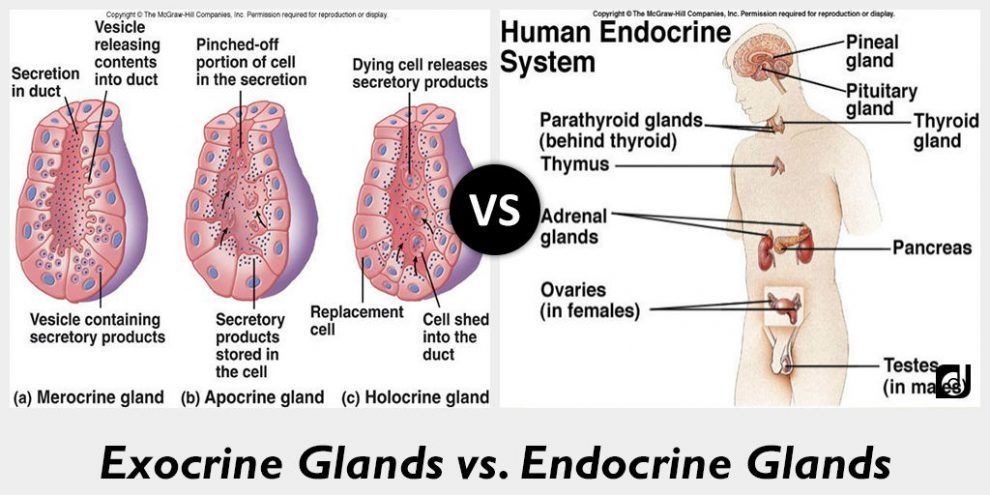 In the gland, the right
In the gland, the right
and the left lobe and the isthmus connecting them. From the isthmus in some people departs
upward process, called the pyramidal lobe. The gland is located in the anterior
neck and covered with fascia. The lobes of the gland are adjacent to the thyroid cartilage of the larynx and to the cartilages
trachea; the isthmus is located in front of the 2nd-4th tracheal rings. outside iron
has a fibrous capsule, from which partitions extend inward, separating the substance
glands into lobules. In the lobules between the layers of connective tissue are
follicles (vesicles). The walls of the follicles are made up of a single layer of glandular cells.
– thyrocytes. The size (height) of thyrocytes changes in accordance with their
functional state. With moderate activity, they have a cubic shape, and
With moderate activity, they have a cubic shape, and
with increased secretory activity, they swell and take the form of prismatic
cells. The cavity of the follicles is filled with a thick substance – a colloid, which
secreted by thyrocytes and contains hormones.
Thyroid hormones – thyroxine and triiodothyronine – influence
on various types of metabolism, as well as on the activity of the nervous system. At
hyperfunction of the gland (excessive secretion of hormones) thyrotoxicosis develops
(Graves’ disease), with hypofunction – myxedema,
The thyroid gland, parathyroid glands and the thymus gland are formed from
rudiments of gill pockets (endodermal origin) and together make up
branchiogenic group of glands (branchiae – gills).
Parathyroid (parathyroid) glands (glandulae parathy-roideae),
two upper and two lower, are small bodies of oval or rounded
forms, each weighing up to 0.09 g. They are located on the back surface of the right and left
lobes of the thyroid gland along its arterial vessels. Connective tissue
the capsule of each gland sends processes inside. between layers of connective tissue
tissue contains glandular cells – parathyrocytes. They secrete a hormone
parathyroid glands parathyrin (parathyroid hormone), which regulates calcium metabolism and
phosphorus in the body.
The thymus, or thymus (thymus), consists of two lobes: the right
and left, connected by loose connective tissue. She is at the top
She is at the top
anterior mediastinum, behind the manubrium of the sternum. In children, iron with its upper end
can protrude through the upper opening of the chest into the neck. Mass and
The size of the gland changes with age. In a newborn, the mass of the gland is about 12 g,
increases rapidly in the first two years of a child’s life, the largest value (up to 40 g)
reaches the age of 11-15 years. Age begins at the age of 25
involution of the gland – a gradual decrease in the glandular tissue with its replacement
fatty tissue.
According to the International Anatomical Nomenclature, the thymus belongs to the group of endocrine
glands. At present, the thymus gland is usually referred to as the hematopoietic organs.
and immunological protection. In addition to the thymus, these organs include red bone
brain, lymphatic follicles of the digestive system and other organs,
body lymph nodes and spleen. The thymus gland is called the central organ
immunity; it reproduces immune cells – T-lymphocytes.
The precursors of T-lymphocytes are lymphoblasts – special cells that
entering the thymus from the red bone marrow.
The thymus gland is covered with a connective tissue capsule, from which processes extend,
separating the substance of the gland into lobules. Each lobule is divided into cortical and medullary
substance. The basis of the lobules is arranged in the form of networks of process
epithelial cells, between which there are T-lymphocytes. The cortical substance
The cortical substance
compared with the medulla, the gland lobules contain significantly more lymphocytes and
darker color. The cortex also contains lymphoblasts. In the process of them
division, new T-lymphocytes arise. There is a constant transition of T-lymphocytes from
cortical substance into the blood and their migration to the lymph nodes and spleen, where
neither mature into active cells. T-lymphocytes of the medulla
their ultra-microscopic structure and properties are somewhat different from
T-lymphocytes of the cortex; they are not formed in the thymus medulla, but
enter it from the blood. Inside the medulla there are concentric bodies,
or Hassall’s little bodies, consisting of epithelial cells arranged in circular layers.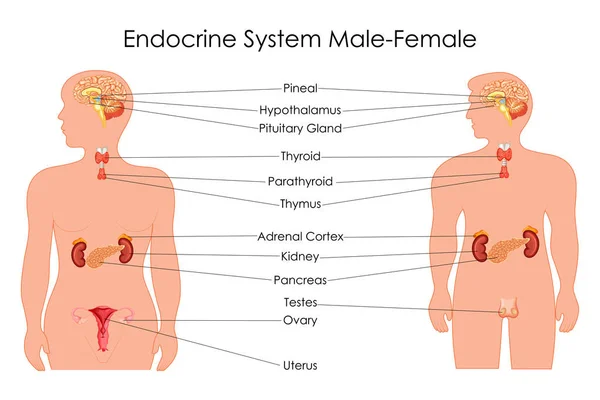
Various biologically active substances have been isolated from the thymus gland, affecting
some body functions, including hematopoiesis (hormone thymosin),
carbohydrate metabolism (insulin-like factor), growth (growth factor), calcium metabolism and
phosphorus, etc. Removal of the thymus in young animals leads to growth retardation, and then
to death.
Adrenal gland, right and left, or the adrenal gland is located in
retroperitoneal space above the upper end of the corresponding kidney. Right
the adrenal gland is triangular in shape, the left one is semi-lunar; the mass of each gland is approx.
10g.
There are two layers in the adrenal gland: the outer yellow layer is the cortical substance (bark) and
the inner brown layer is the medulla.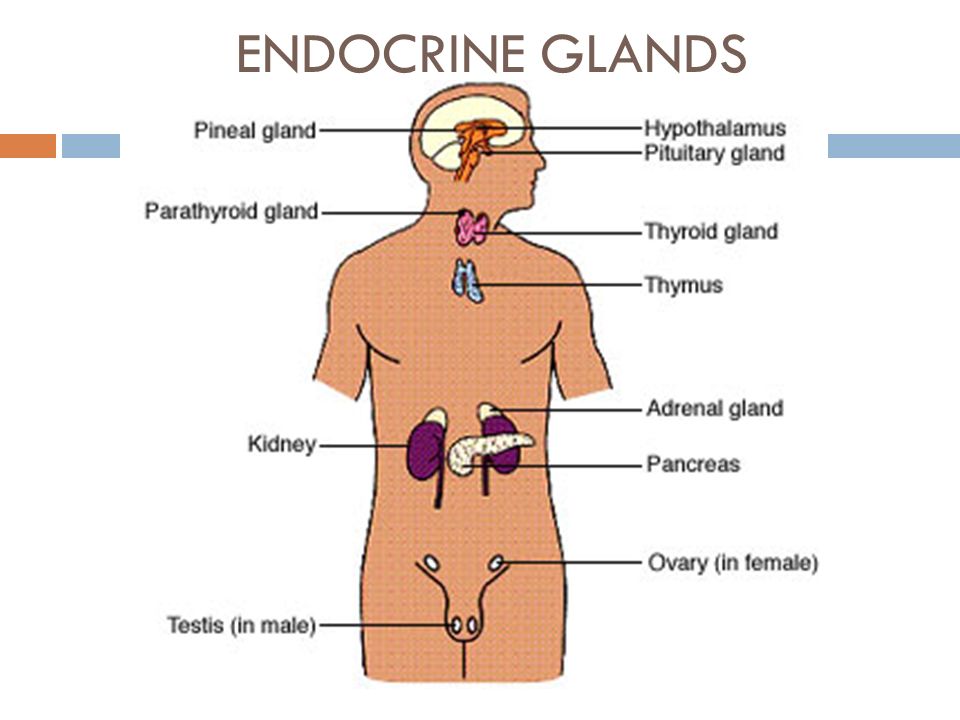 These two layers differ in structure
These two layers differ in structure
and origin, as well as the hormones they secrete and united into one gland in
development process.
The cortical substance is a derivative of the mesoderm, it develops from the same rudiment as
and gonads from the coelomic epithelium It consists of epithelial cells,
between which there are thin layers of loose connective tissue with vessels and
nerve fibres. Depending on the structure and location of epithelial cells in
three zones are distinguished in the adrenal cortex: the outer to l at the barrel, the middle beam and
inner mesh.
Mineralocorticoid hormones are produced in the zona glomeruli of the adrenal cortex
(aldosterone, etc., affect the water-salt metabolism in the body) in the beam zone—
glucocorticoids (involved in the regulation of carbohydrate, protein and fat metabolism) and in
reticulate – sex hormones (androgens and estrogens, have an effect,
similar to sex hormones). Normal sex hormones of the adrenal cortex
Normal sex hormones of the adrenal cortex
are produced mainly in childhood, when the intrasecretory function
ovaries (or testicles) is not yet expressed.
The adrenal medulla is derived from the ectoderm and develops from the same
rudiment, as the nodes of the sympathetic trunks. It is made up of glandular cells.
called chromaffin. Adrenal medulla hormones
epinephrine and norepinephrine (catecholamines, affect various functions
organism, similar to the influence of the sympathetic division of the autonomic nervous system).
Accumulations of chromaffin cells, in addition to the adrenal medulla, are found in
called paraganglia – small bodies located in some places
body, for example, at the division of the common carotid artery into internal and external (carotid
glomus – tangle), near the abdominal aorta (lumbar aortic paraganglion).
Security questions:
- What glands are called endocrine glands? 2. What do the terms mean
“endocrine” and “hormone”? 3. List the endocrine
glands. 4. Location of each endocrine gland. 5. Key features
structure of the endocrine glands. 6. What is the leading role of the anterior lobe
pituitary in the endocrine system? 7. Pituitary gland; position, weight. 8. Shares
pituitary gland: name, from what developed? 9. Pineal body: position, mass,
Latin name. 10. Thyroid gland: position, mass, Latin name.
11. Parathyroid glands: position, quantity, name of the hormone of these glands.
12. Thymus gland: position, shares, Latin name. 13. What are they made of
What are they made of
thymus lobules? . 14. Adrenal glands: position, approximate weight. 15.
Two layers of the adrenal gland: name, mutual position, what did they develop from? 16. Three
zones of the adrenal cortex, the general name of the hormones secreted by each zone.
Anatomy: endocrine system | USE in biology
Endocrine system
Humoral regulation is the coordination of physiological functions with the help of biologically active substances through body fluids – blood, lymph and tissue fluid.
Biologically active substances are substances produced by cells and tissues of the body and have a strong stimulating effect on body functions. These include hormones, vitamins and other substances. Most vitamins enter the human body from the outside, while hormones and other substances are produced by special glands.
The glands of the human body are divided into glands of external, internal and mixed secretion. external secretion glands include all glands that have ducts and periodically discharge their products into the organ cavity or out. These are salivary, lacrimal, sweat, sebaceous and other glands. They produce digestive enzymes, lacrimal fluid, sebum, etc. Endocrine glands produce hormones that enter the internal environment of the body. Glands of mixed secretion excrete their products both into the blood and into the organs of the body.
Hormones are biologically active substances produced by the glands of internal and mixed secretion and acting in target tissues in microscopic quantities.
However, the effect of hormones does not extend to the entire body, but only to specific cells, tissues and organs. This property is called specificity. The lack of hormones associated with the hypofunction of the corresponding gland, as well as the excess due to its hyperfunction, negatively affect the vital activity of the body, leading to the appearance of pathological changes.
The totality of glands of internal and mixed secretion is called the endocrine system of the organism . The structure and functions of the endocrine glands are studied by science endocrinology .
The endocrine system of the human body is formed by the hypothalamus, pituitary gland, pineal gland, thyroid gland, parathyroid glands, pancreas, adrenal glands and sex glands (ovaries and testicles).
Hypothalamus — part of the diencephalon, the highest center of neurohumoral regulation in the human body. It produces substances that affect the formation of pituitary hormones, as well as two hormones only released by the pituitary gland – vasopressin (antidiuretic hormone) and oxytocin. Vasopressin retains water in the body during urination. A decrease in the concentration of this hormone leads to rapid loss of water and even dehydration. Oxytocin stimulates labor activity, causing the fetus to be expelled from the uterus.
The pituitary gland is a small gland located at the base of the brain that produces a number of hormones, as well as releases vasopressin and oxytocin produced by the hypothalamus. Pituitary hormones stimulate the activity of other endocrine glands. These include adrenocorticotropic hormone (ACTH), gonadotropic hormones – luteinizing (LH) and follicle-stimulating (FSH), lactotropic hormone, or prolactin (LTH), melanocyte-stimulating hormone (MSH), growth hormone (STH) and thyroid-stimulating hormone (TSH).
Pituitary hormones stimulate the activity of other endocrine glands. These include adrenocorticotropic hormone (ACTH), gonadotropic hormones – luteinizing (LH) and follicle-stimulating (FSH), lactotropic hormone, or prolactin (LTH), melanocyte-stimulating hormone (MSH), growth hormone (STH) and thyroid-stimulating hormone (TSH).
ACTH regulates the activity of the adrenal glands and stimulates the secretion of their hormones. Gonadotropic hormones contribute to the formation of the gonads and their normal functioning. LTH causes mammary glands to enlarge and produce milk in the mother after the baby is born. MSH enhances human skin pigmentation. STG stimulates the growth of the body. Lack of growth hormone leads to dwarfism , while body proportions and mental development remain normal. Excess GH causes gigantism , and if the concentration of the hormone increases in an adult, then the size of individual protruding organs increases – this disease is called acromegaly . TSH controls the activity of the thyroid gland.
TSH controls the activity of the thyroid gland.
Pineal gland , or pineal gland , which is part of the diencephalon, is involved in the regulation of biological rhythms of the body and produces the hormone melatonin, which causes skin lightening.
Thyroid , located in the middle region of the neck, secretes the thyroid hormones thyroxine and triiodothyronine, as well as calcitonin. Thyroid hormones regulate metabolism in the body, contributing to the normal processes of growth, development and differentiation of tissues. Calcitonin lowers the level of calcium in the blood by depositing it in the bones.
Hyperfunction of the thyroid gland leads to an increase in the intensity of metabolism, excitability of the nervous system, insomnia and the development of goiter. The complex of these symptoms is called Graves’ disease . Hypofunction of the thyroid gland, on the contrary, causes a slowdown in the metabolism that accumulates in the skin, and increases the excitability of the nervous system. This disease is called myxedema . Lack of thyroid hormones in childhood and adolescence leads to dwarfism and cretinism.
This disease is called myxedema . Lack of thyroid hormones in childhood and adolescence leads to dwarfism and cretinism.
Parathyroid glands are located on the surface of the thyroid gland and secrete parathormone. It increases the level of calcium in the blood and therefore is an antagonist of calcitonin. Hyperfunction of the parathyroid glands can lead to bone disorders and osteoporosis.
Adrenal glands are paired endocrine organs located near the top of the kidneys. In the adrenal glands, the cortical layer and the medulla are isolated. Corticosteroids are formed in the cortical layer of the adrenal glands, and adrenaline and noradrenaline are formed in the medulla. Corticosteroids regulate the metabolism of organic and inorganic substances in the human body. Their deficiency leads to Addison’s (bronze) disease , the symptoms of which are increased skin pigmentation, weakness, dizziness, arterial hypotension, vague pain in the intestines and diarrhea.
Adrenaline is secreted by the adrenal glands in many critical situations. It enhances the work of the heart, constricts blood vessels, inhibits digestion, increases oxygen consumption, increases the concentration of glucose in the blood, blood flow in the liver, etc. The release of adrenaline into the blood is associated with the action of strong irritants on the human body and is an integral component of the body’s stress reactions.
Glands of mixed secretion include pancreas and gonads.
The pancreas , in addition to digestive enzymes, secretes the hormones insulin and glucagon into the bloodstream, which regulate carbohydrate metabolism. Insulin reduces the concentration of glucose in the blood, facilitating its binding in the liver and other organs, and glucagon , on the contrary, increases the concentration of glucose in the blood due to the breakdown of glycogen in the liver. Lack of insulin, leading to an increase in the concentration of glucose in the blood, causes the development of diabetes mellitus . Excess insulin can lead to a sharp drop in glucose concentration, loss of consciousness and convulsions. Deviations in the content of glucagon in humans are extremely rare.
Excess insulin can lead to a sharp drop in glucose concentration, loss of consciousness and convulsions. Deviations in the content of glucagon in humans are extremely rare.
Sex glands simultaneously produce sex products and sex hormones (female – estrogens , male – androgens ), exerting a significant influence on the processes of growth, development and puberty, as well as regulating the formation of secondary sexual characteristics.
Neurohumoral regulation of the vital processes of the body as the basis of its integrity,
connections with the environment
The nervous and endocrine systems are an inseparable unity, due to numerous direct and feedback connections. Receiving signals from various receptors is the prerogative of the nervous system, which is included in the work of the first. Its impulses instantly and accurately affect the organs, changing their activity. However, the control from the nervous system is short-lived, it acts pointwise, while in order to “fix” the effect and involve the whole organism in the reaction, the signal through the hypothalamus also goes to the endocrine system.

 Hormones made by the pancreas include insulin and glucagon. These regulate blood sugar levels.
Hormones made by the pancreas include insulin and glucagon. These regulate blood sugar levels.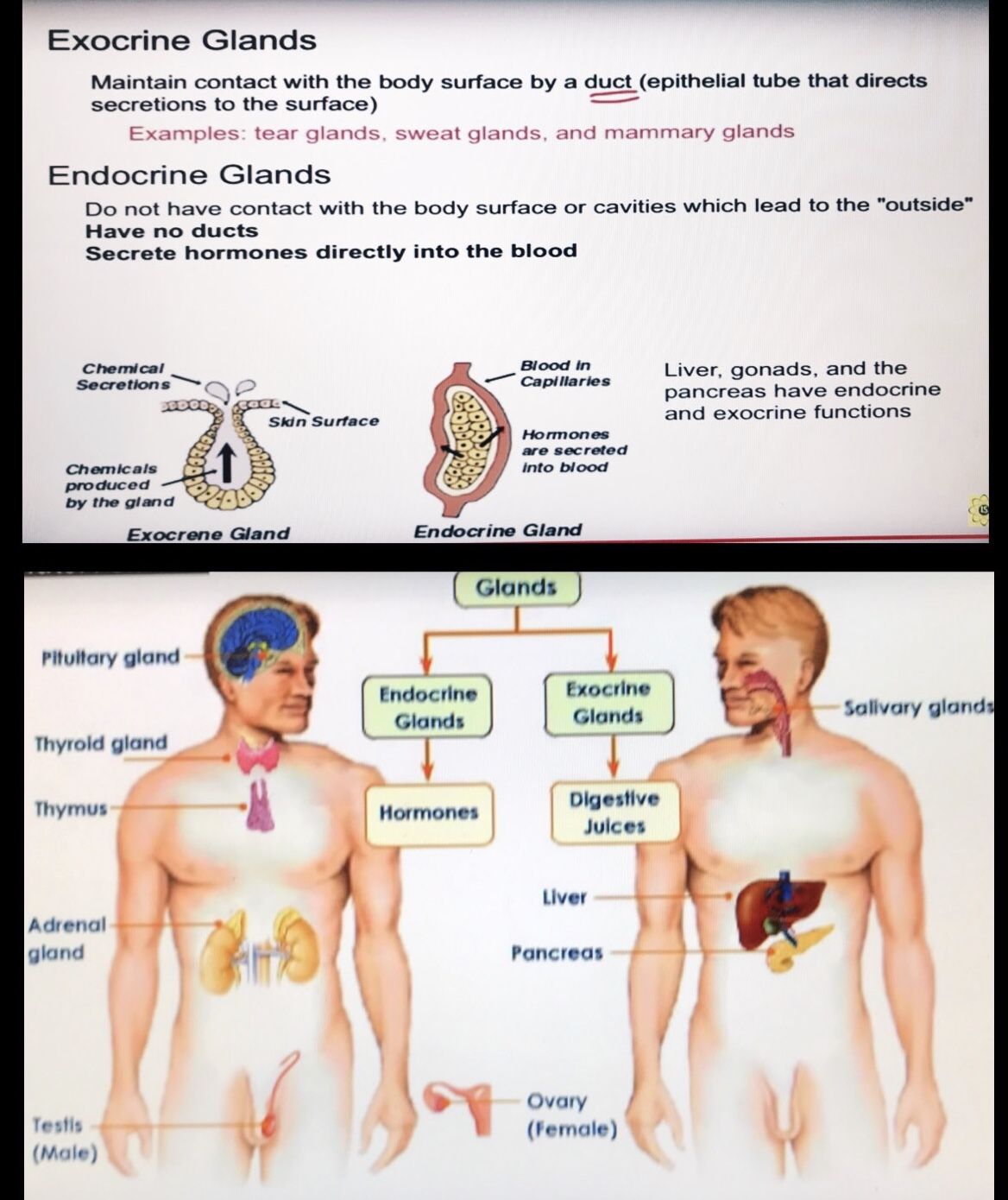
 What are they made of
What are they made of